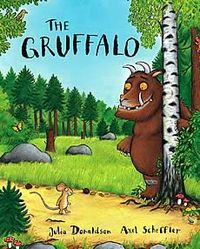 The gruffalo
The gruffalo
Resource
The Gruffalo by Julia Donaldson and Axel Scheffler
Read or watch The Gruffalo.
The book is widely available. The animated version by the BBC seems to be broadcast regularly. There are also the following video versions online:
1. A storytelling version with 8 year olds
2. Animation with narration
Concepts
Draw out the main concepts. Begin by asking children what they think the main ideas of the story were, or what Julia Donaldson was trying to teach young children by writing the story. The concepts my children focussed on included: Telling lies; believing others; existence (of the Gruffalo); being brave; being scared; feeling stupid (when the animals realised they’d been lied to by the mouse); talking animals; survival of the fittest; cunning.
Philosophical questions
Ideally, children will create their own questions from the concepts they’ve spotted. Here, though, are some questions composed by other children:
- What is bravery?
- What makes someone believable?
- Would you be stupid if you believed someone who was telling a lie?
- How do we know that animals can’t talk the way humans can?
- Is it always good to be brave?
- What if animals could talk to us?
- Is it possible to be cunning and stupid at the same time?
- Can telling lies ever be a good thing?
- What is the difference between being brave and being stupid?
- Can we be sure there’s no such thing as a gruffalo?
Choose the best question
For example, ‘Can we ever be sure there’s no such thing as a gruffalo?’
First words
For example, ‘I’ve never seen a gruffalo so I know they’re not real’; ‘there might be creatures very similar to gruffalos that live in undiscovered forests somewhere’; ‘I’d love gruffalos to be real’.
Build and challenge
Questions that would help to build children’s ideas include:
- Can we think of an example of something we’ve never seen but we know exists?
- Why do you say that you’d love gruffalos to be real?
- Are there any other reasons you can think of to suggest that gruffalos are real but just haven’t been discovered yet?
- What evidence is there to support your idea that there might be creatures very similar to gruffalos alive on the planet?
- Could anyone say why he or she agrees with what ‘A’ thinks?
Questions that might challenge children’s ideas:
- Do we have to see something to believe it?
- If I’ve never seen a duck-billed-platypus, does that mean they aren’t real?
- What are the consequences of assuming that if we think we’ve seen something that that makes it real?
- What would happen if the opposite were true – that gruffalos were real but scientists kept them (and other creatures) hidden from us?
Search for truth
A classic story to talk about when thinking about existence and reality is Plato’s story of the cave.
This is about a group of prisoners chained up at the bottom of a cave, who spend their whole lives staring at the wall in front of them. Eventually one of the prisoners is released. As his eyes adjust to the light outside the cave, he sees the real world in front of him. This amazes him because until then he’d only ever seen the shadows bouncing around the walls of the cave. Feeling sorry for the prisoners he left behind, he returns excitedly to tell them all about the real world he has seen outside the cave. However, since his eyes are no longer used to the darkness of the cave, he stumbles and falls causing his fellow inmates to suspect he has turned blind. When he describes the world outside, the other prisoners refuse to believe him, thinking him mad, and so ostracise him. The other prisoners never do get to witness the real world outside.
Plato’s story prompts the question: are we like the prisoners in the cave, witnessing only the shadows of the real world? And how can we be sure either way? Though it might be a stretch to then talk about gruffalos, but how do we know that gruffalos don’t exist? Perhaps Julia Donaldson is the prisoner that was released and this is her way of telling us about the real world?
Construct an answer
An Inference square would be a suitable strategy to help children make more sense of their thinking at this point.

Final words
I’d be inclined to go either for a vote, or for identifying any further questions we could ask.
Vote
- Can we ever be sure that there’s no such thing as a gruffalo? Options – yes; no; not sure
- You could then go for a follow-up question, asking children whether their opinion has changed during the discussion and, if so, why.
Further questions about the question
- How could we know whether the world we’re in is the real one or not?
- Can we trust our five senses or is it best to rely on our sixth sense instead?
- Which are you most likely to trust – something you see, something you hear, or something you touch?
- Is there a difference between knowing and believing?
- f you met a real-life gruffalo, what would you do?
